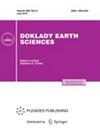作为外贝加尔地区东南部现代气候湿度指标的麻黄花粉变异性花粉作为外贝加尔东南部现代气候的湿度指标
IF 0.7
4区 地球科学
Q4 GEOSCIENCES, MULTIDISCIPLINARY
引用次数: 0
摘要
对不同年份在托雷湖地区采集的麻黄标本材料的研究揭示了其花粉粒的形态变异性。花粉粒假珠心和柱状(脊)数量的发展与生长季节的温度和湿度值之间存在反比关系。在潮湿的季节,植物产生的花粉粒只有很少的假珠心。在干燥和凉爽的生长季节,假珠心的数量会增加。本文章由计算机程序翻译,如有差异,请以英文原文为准。

Variability of Ephedra dahurica Turcz. Pollen as an Indicator of Humidity for the Modern Climate of Southeastern Transbaikalia
Abstract
The study of herbarium materials of the Ephedra dahurica Turcz. collected in the Torey Lakes region in different years has revealed the morphological variability of its pollen grains. An inverse relationship has been established between the development of the number of pseudosulci and plicae (ridge) of pollen grains and the values of temperature and humidity during the growing season. During wet seasons, the plant produces pollen grains with few pseudosulci. The number of pseudosulci increases during dry and cool growing seasons.
求助全文
通过发布文献求助,成功后即可免费获取论文全文。
去求助
来源期刊

Doklady Earth Sciences
地学-地球科学综合
CiteScore
1.40
自引率
22.20%
发文量
138
审稿时长
3-6 weeks
期刊介绍:
Doklady Earth Sciences is a journal that publishes new research in Earth science of great significance. Initially the journal was a forum of the Russian Academy of Science and published only best contributions from Russia. Now the journal welcomes submissions from any country in the English or Russian language. Every manuscript must be recommended by Russian or foreign members of the Russian Academy of Sciences.
 求助内容:
求助内容: 应助结果提醒方式:
应助结果提醒方式:


